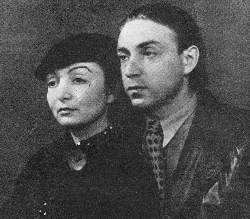Imre Ámos

Imre Ámos (1907 in Nagykálló, Hungary – 1944 or 1945 in Ohrdruf, Germany) was a twentieth century Hungarian Jewish painter.
Following his studies at the Technical University, Budapest from 1927 to 1929, he enrolled in the Art School where he was a pupil of Gyula Rudnay. He married Margit Anna, also a painter.
His painting was initially influenced by József Rippl-Rónai and Róbert Berény. From the mid-1930s onwards, his style emulated that of Chagall whose influence affected his artwork in his paintings such as The Old Church Servant Thinks of Heaven, and the Dream of Bear Leader.
In 1936, he was elected to be a member of the New Society of Artists, which entailed working in Szentendre during the summer months. He visited Paris in 1937 where he met Chagall. Ámos became a member of the National Salon in 1938.
Some of his works show the influence of legends about the famous Chassidic Kaliver Rebbe, Rabbi Yitzchak Isaac Taub (1744–1828), who was also from Nagykálló.
In 1940 during World War II he became a victim of the Holocaust because he was Jewish. He was taken to a forced labour camp in Vojvodina, then to the battlefield in the east. In 1944 he was deported to a concentration camp in Saxony where he later died cruelly.[1] Throughout the war he painted about his tragic experiences in shocking visions such as A eries of Dark Times, Escaping, and War.
He died only aged 37 or 38.
Some of the works by Imre Ámos and his wife can be seen in the Museum of Margit Anna and Imre Ámos in Szentendre.
On 23 June 2014, the Jewish Historical Institute opened the exhibit “Where is your brother?—Imre Ámos and the 20th century.”[2]
References
- ↑ Shelley, Alexandra (November 18, 1990). "SoHo on the Danube: An Artist's Village". The New York Times.
- ↑ Jewish Historical Institute. http://www.jhi.pl/en/events/book_promotions/269
|